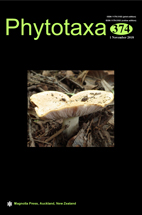Abstract
The Gracilariales is a red macroalgal order and the main global source of the economically important agar, a marine phycocolloid. Independent comparative morphological and molecular phylogenetic studies over the last 20 years have revealed the existence of seven major clades recognizable as distinct genera. Of these major clades only four free-living genera have been widely accepted taxonomically: Curdiea, Melanthalia, Gracilariopsis, and Gracilaria. Three other clades comprise the reinstatement of the genus Hydropuntia and the proposal of two new genera, Agarophyton and Crassa, described herein. Based on new rbcL DNA sequences, and along with a reassessment of published comparative morphological and molecular phylogenetic studies, we argue that the latter three genera represent distinct evolutionary lineages in the Gracilariaceae, and propose a new classification for the order Gracilariales. Our new proposal incorporates the most current understanding of the evolutionary history of the order, establishes a natural and stable classification system, and provides the basis for the recognization of intra-family ranks. Our classification scheme reconciles all molecular phylogenetic studies published to date.

